The X Button
Shadowplay
by Todd Ciolek,

I think I owe some people an apology. In last week's column I mocked those of you who put off buying Patapon 2 for $20 simply because it's a download-only title. I figured it didn't matter, since the game was shipping at a budget price and the industry's favoring downloadable games more and more. Well, just as that column was going up, Capcom announced that Fate/Unlimited Codes will come out in North America as a download-only PSP game for $29.99. And now I'm starting to see why Patapon fans were upset.
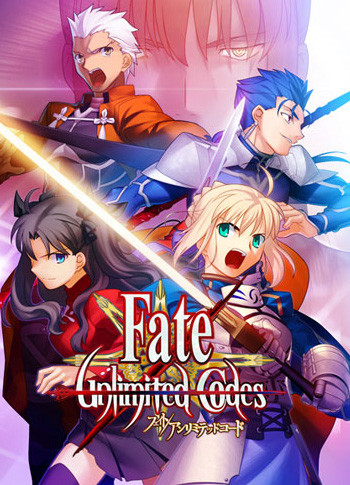
I realize Fate/Unlimited Codes was unlikely to get released in North America, since it's a crazily complicated fighting game (one niche) based on an anime-manga-game franchise with no mainstream hooks in North America (another niche). Capcom's not skimping on the translation either, since the English version will have the story mode and other extras found in the Japanese one. And hey, people buy download-only games on the Wii, Xbox 360, PC, and PlayStation Network all the time, so does it make that much of a difference when Capcom ditches the case, instructions, and physical UMD to bring us a PSP game?
Well, it might. Numerous anime fans will be interested in Fate/Unlimited Codes, and anime fans do enjoy getting physical media for their money, as shown in those photos of rooms wallpapered with anime DVDs. Not that anyone expected Capcom to release the game with a box set and special-edition Saber figure, but for thirty bucks, Fate/stay night fans will probably want something they can hold in their hands.
NEWS
SOUL CALIBUR, TEKKEN 6 COMING TO PSP
Namco has kept console owners waiting on Tekken 6 for well over a year, so perhaps it'll comfort them to have the latest Tekken and Soul Calibur: Broken Destiny for the PSP. Tekken 6 will be a port of the arcade game with some as-yet-unspecified features as well as all of the characters, including newcomers Leo, Zafina, Miguel, and the comically overweight Bob. Considering how impressive Tekken: Dark Resurrection was in recreating the arcade Tekken 5 on the PSP, it's safe to say that the system can handle Tekken 6 in a similar way. Whenever it comes out, that is.
Soul Calibur: Broken Destiny is slightly different, as it apparently won't be a straight port of Soul Calibur IV. It'll have local head-to-head play and that lovely create-a-fighter mode, though Namco has only confirmed a few returning characters; so far the lineup is Taki, Siegfried, Voldo, Ivy, Cassandra, Tira, Astaroth, and Hilde. There'll be at least one new fighter, Dampierre, and he pretty much makes the entire game worthwhile.
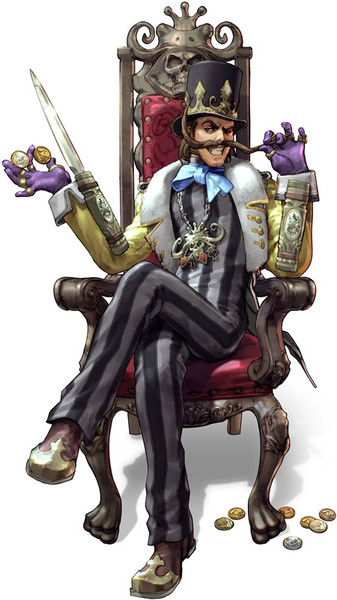
Yeah, I'd say he fits a 16th-century fighting game better than Darth Vader and Yoda, who won't be back for Broken Destiny.
VALHALLA KNIGHTS HEADS TO WII
In the recent explosion of dungeon-hack RPGs, Valhalla Knights went largely unnoticed as cults gathered around Etrian Odyssey and Mystery Dungeon: Shiren the Wanderer. That doesn't mean Valhalla Knights was a flop, though. After two PSP titles, it's moving to the Wii with Valhalla Knights: Eldar Saga. Like the recent Dark Spire, Valhalla Knights is a dungeon hack of distinctly Western inspiration: the characters are player-created Dungeons and Dragons representatives with only minor anime exaggeration, and their world is frequently grim and down-to-earth.
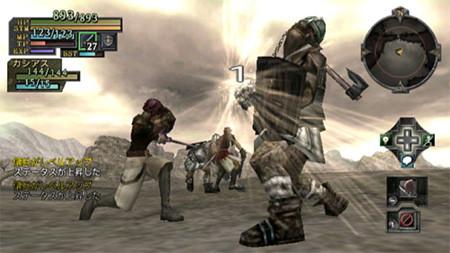
The appeal of Valhalla Knights is in its exploration, in its battle-heavy dungeons and wide overworld. It's the sort of thing that would work out nicely as an online RPG, but Eldar Saga seems limited to only two players cooperating online, without any in-person multiplayer options. If it's the ugly, cruel stepsister of the dungeon-hack movement, XSEED Games is still going to give it a shot at the North American Wii market this summer.
KATAMARI FOREVER MILKS GOOD IDEA EVEN MORE
Katamari Damacy creator Keita Takahashi pretty much left the series after the second game, yet that hasn't stopped Namco Bandai from making more of it. As Takahashi busies himself with Noby Noby Boy, a bunch of older Katamari Damacy stages get revamped next to new ones in Katamari Forever.
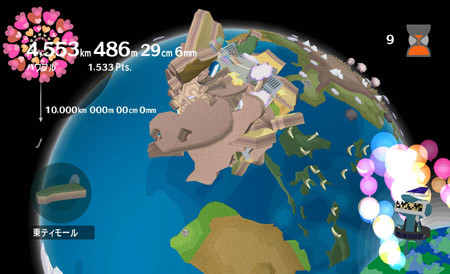
Levels from previous games are shown in black and white, as they're taking place within the hazy memories of the towering, power-abusing King of All Cosmos. New challenges revive the star-making premise of the original game, though the tiny cosmic Prince now takes on specific tasks with his rolling accumulations. One level has him soaking his base Katamari ball and using it to water plants throughout a forest. It's still more exploitation of an idea that probably ran its course two games ago, but fans can see just how much they still care about Katamaris when Forever arrives on the PlayStation 3 this fall.
IN BRIEF: SQUARE' S MYSTERY GAME, SPECIAL BLAZBLUE STUFF
So Square Enix has a teaser site for a new, unnamed game? Let's round up the suspects from Square's recent trademark-registering history. Could it be Vanguard Storm? Possibly so, but the site shows a futuristic cityscape where explosions flicker and clanking, robotic footsteps echo. And Square just registered the title Front Mission Evolved, presumably the latest in a line of strategy-RPGs full of near-future political upheaval and enormous military mecha. I think we have a match. One thing, Square Enix: if this is a new Front Mission, try not to leave it in Japan like you did Front Mission 5, please?
I mentioned BlazBlue's bonus GameStop-exclusive art book last week, but Aksys Games just clarified the contents of the limited edition that you get when preordering it anywhere. There's a 48-song soundtrack and an elaborate tutorial video that walks players through the game's less obvious concepts, the sort of helpful guide that I wish I'd had when learning Guilty Gear years ago. It'll also have limited-edition packaging, though perhaps not as spectacular as the Devil Summoner 2 box we'll see below.
REVIEW: BLUE DRAGON PLUS
 Developer: Brownie Brown/Feelplus
Developer: Brownie Brown/Feelplus
Publisher: Ignition Games
Platform: DS
MSRP: $29.99
Nearly everyone who played Mistwalker's Blue Dragon agreed that it really, really wanted to be the new Dragon Quest. Of course, it would be foolish for any modern-day RPG to attempt the sort of genre takeover that Dragon Quest pulled back in the 1980s, and perhaps Mistwalker realized that the market was just too crowded and demanding for that. Blue Dragon's been content to be just another franchise, with its own toys, manga, a cartoon, and a DS-based sequel that's a little less ambitious than the Xbox 360 game.
No one needs to play the original Blue Dragon to understand what's afoot in Blue Dragon Plus. The first game, like 90 percent of all Japanese RPGs ever made, saw a band of scrappy young heroes defeat an overlord sorcerer and his ancient technology. About a year after all of that, the overlord in question, Nene, returns and stirs up conquest and the high-tech secrets of a forgotten age just in time for Blue Dragon Plus. All of the cast members, new or old, get introduced with a few screens of text, and the game wastes little time; instead of building up a 30-hour quest to fight Nene again, the heroic Shu and his friends face him about an hour in, and from there the story builds itself some new concepts. It's all faithful to the tone laid down in the first Blue Dragon: brisk, lighthearted, and just as suffused with clichés as any comic filling space in a manga anthology for kids ages 7-12.
 Blue Dragon Plus wisely leans more toward battles than complex storytelling, with the free-roaming, real-time strategy-RPG skirmishes popularized by Heroes of Mana and Final Fantasy XII: Revenant Wings. Not unlike some Starcraft clone by way of Akira Toriyama, Blue Dragon Plus has its characters actively wandering around in groups, attacking enemies and casting magic as the player pokes at them with the DS stylus. Characters get the usual spates of magic spells and special attacks, unleashed with their personalized shadow-creatures, and half the challenge lies in keeping track of who's doing what.
Blue Dragon Plus wisely leans more toward battles than complex storytelling, with the free-roaming, real-time strategy-RPG skirmishes popularized by Heroes of Mana and Final Fantasy XII: Revenant Wings. Not unlike some Starcraft clone by way of Akira Toriyama, Blue Dragon Plus has its characters actively wandering around in groups, attacking enemies and casting magic as the player pokes at them with the DS stylus. Characters get the usual spates of magic spells and special attacks, unleashed with their personalized shadow-creatures, and half the challenge lies in keeping track of who's doing what.
It's a liberated take on the typical Japanese strategy-RPG, and yet it rarely works to its fullest. As in Final Fantasy XII: Revenant Wings, battle tactics in Blue Dragon Plus are painted broadly, with combat degenerating into huge melees where the player need only keep an eye on the party's health while launching destructive attacks whenever possible. The game stumbles most when it comes to those special moves. Characters can only use their shadow-backed powers when a suitable target is in range, and the player can't give the command until the target appears. Strategy games thrive on maneuvers plotted out in advance, and the on-the-fly directions in Blue Dragon Plus are often annoying.
 Blue Dragon Plus seems to understand that it's a mess. The game isn't terribly difficult so long as you put some thought into it, and only the last stretch of the 30-hour quest gets particularly challenging. While there's no dungeon-plumbing on par with a traditional RPG, players can explore mazes by moving multiple parties from room to room. There's also a robust lineup, as just about every character of importance in Blue Dragon becomes playable in Plus, with his or her own unique attacks. The game's battles show off decent enough character sprites and environments, with a lot of reasonably impressive video sequences popping up. There are no voices to speak of, and Nobuo Uematsu, of the original Blue Dragon and a whole lotta Final Fantasies, chips in with a soundtrack that's largely inconspicuous, never topping the boss-battle theme from the original Blue Dragon.
Blue Dragon Plus seems to understand that it's a mess. The game isn't terribly difficult so long as you put some thought into it, and only the last stretch of the 30-hour quest gets particularly challenging. While there's no dungeon-plumbing on par with a traditional RPG, players can explore mazes by moving multiple parties from room to room. There's also a robust lineup, as just about every character of importance in Blue Dragon becomes playable in Plus, with his or her own unique attacks. The game's battles show off decent enough character sprites and environments, with a lot of reasonably impressive video sequences popping up. There are no voices to speak of, and Nobuo Uematsu, of the original Blue Dragon and a whole lotta Final Fantasies, chips in with a soundtrack that's largely inconspicuous, never topping the boss-battle theme from the original Blue Dragon.
For the young Blue Dragon fan, Plus is a stable diversion, but older, more discerning players can do better. On the DS alone, they have Valkyrie Profile: Covenant of the Plume, Disgaea, Final Fantasy Tactics A2, a Front Mission port, two Luminous Arcs, and Fire Emblem. They don't need a free-roaming strategy-RPG that can't put together responsive, engaging battles. Like the original Blue Dragon, Plus suffers most not for what it is, but for where it is: a world where anime-style RPGs need to be more than just passably entertaining.
RELEASES FOR THE WEEK OF 5-10
KLONOA Klonoa should be out this very week instead of the next, yet I cannot fail to mention it here. After all, this means that Klonoa can now be scratched off that list of great game franchises lying dormant and neglected. Well, a check-mark in pencil might be better, because this game, simply titled Klonoa, is a remake of 1997's Klonoa: Door to Phantomile. The original game won praise for having traditionally 2-D gameplay at a time when everyone else was scrambling to rip off Super Mario 64, and the remake has the same approach. Not that it's limited as a side-scroller, as Klonoa builds complex, multi-plane, puzzle-like stages out of the concept of its big-eared cat hero snaring enemies and using them to launch himself all over the place. The game's 3-D engine gives it plenty of visual depth, it supports Classic controllers in addition to the nunchuk, and Namco also threw in some extra levels, including tougher mirror versions of the basic stages. The characters still speak in indecipherable gibberish, though there's now an English track for those who want to understand the voices. And there's no sign of that redesigned, bat-eared Klonoa that Namco showed last year and quickly swept under the rug.
|
PUCHI PUCHI VIRUS Developer: KeysFactory Inc.
Developer: KeysFactory Inc.Publisher: NIS America/KOEI Platform: DS MSRP: $19.99 There's likely a low-level betting pool on whether or not Puchi Puchi Virus will come out. NIS America announced this Jaleco-backed puzzle title back in 2007, but it spent 2008 being rescheduled, and Jaleco folded early this year. Fortunately, puzzle games seldom go out of date, and Puchi Puchi Virus has the makings of a good one. As bizarrely cute medical assistants and patients frolic on the top screen, players link viruses on a grid of hexagons. Make a triangle, and all of the viruses within it blink out of existence. It gets more complicated over the game's 100-or-so levels, and there's a multiplayer mode on top of that. Oh, and the procession of patients is an exercise in so-bad-it's-amazing puns, including “Bull Oosley,” “Shino Weevil” and “Orang YouCan.”
|
SHIN MEGAMI TENSEI: DEVIL SUMMONER 2: RAIDOU KUZUNOHA VS KING ABADON Developer: Atlus
Developer: AtlusPublisher: Atlus Platform: PS2 MSRP: $39.99 Devil Summoner 2 may be part of the broad, long-lived Shin Megami Tensei line, but its tone seems closer to the Shadow Hearts RPGs: violent, intentionally campy games that found monstrous uprisings in the early 20th century. Set in a demon-filled 1920s Tokyo, Raidou Kuzunoha vs. King Abadon follows its detective hero on a missing-persons case that, as one might expect in a city of hellish sprites, involves many supernatural forces and roaring-'20s slang (there's something oddly appealing about an RPG where people talk like they're in a parody of The Great Gatsby). Like the first Raidou Kuzunoha showcase, Devil Summoner 2 sets up its battles with some action-oriented flair, as Raidou can move freely and take on enemies by using swords and firearms. He can also capture demons for a variety of magical ends, though Devil Summoner 2 invokes the pantywaist negotiating required in half the games from that other Shin Megami Tensei spin-off series, Persona. What's more, Atlus is dangling some fine promotional goods before customers. See the package on the left? That's not some special edition. Every first-run copy of Devil Summoner 2 comes with a stuffed Jack Frost dressed as Raiho. Also Shipping: Magician's Quest: Mysterious Times, delayed by a week.
|
EXTRA LIVES: MAZIN SAGA
 Mazinger Z was unknown to most of the kids who saw Mazin Saga: Mutant Fighter for the Sega Genesis back in 1993. Perhaps some of them had seen those Americanized Tranzor Z reruns in the 1980s, but few were aware of Gō Nagai's robot series or how it proved popular enough to inspire spin-offs, remakes, decades of other anime shows, and, of course, a Genesis fighting game. To be honest, I hated Mazin Saga for years just because Vic Tokai gave it an English release instead of bringing out the second Trouble Shooter game, but I've since come to forgive them and realize that Mazin Saga isn't bad at all. Well, not at first.
Mazinger Z was unknown to most of the kids who saw Mazin Saga: Mutant Fighter for the Sega Genesis back in 1993. Perhaps some of them had seen those Americanized Tranzor Z reruns in the 1980s, but few were aware of Gō Nagai's robot series or how it proved popular enough to inspire spin-offs, remakes, decades of other anime shows, and, of course, a Genesis fighting game. To be honest, I hated Mazin Saga for years just because Vic Tokai gave it an English release instead of bringing out the second Trouble Shooter game, but I've since come to forgive them and realize that Mazin Saga isn't bad at all. Well, not at first.
As far as I can tell, Mazin Saga is based on a lesser-known 1990s revamp of Nagai's original creation, one where the giant robot of Mazinger fame could also become a human-sized combat suit not unlike the Guyver. Let the title screen of Mazin Saga sit for a while, and you'll read about a conflict between Mazinger pilot (wearer?) Koji Kabuto and the forces of Godkaiser Hell, presumably some new incarnation of Dr. Hell who's conquered the Earth and polluted its ecosystems. I wonder if that last part was embellished by the American localizers. This was the era of Awesome Possum and Once Upon a Forest, after all.
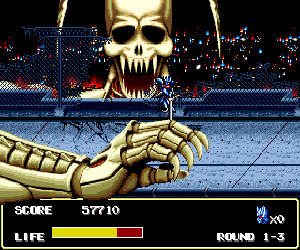 Yet Mazin Saga has no time for stories beyond some opening text and a curt ending. It's all about hacking through stages of hideous enemies, much in the style of Golden Axe and Double Dragon and other games that owned arcades before Street Fighter II ruined everything.
Yet Mazin Saga has no time for stories beyond some opening text and a curt ending. It's all about hacking through stages of hideous enemies, much in the style of Golden Axe and Double Dragon and other games that owned arcades before Street Fighter II ruined everything.
Hopping around the globe, Mazinger faces foes in industrial centers, deserts, and the finest temples of India. It plays out in side-scrolling stages with rather tiny characters, but the controls come through fairly well. Far from the basic punches and kicks of the usual brawlsome game hero, Mazinger has a dash, a mid-air spinning blade, a downward thrust, and a rapid flurry of sword strikes. The opposition starts off with easily dispatched cyborg soldiers and slime-creatures, yet the real fun arrives when gigantic mecha-beasts attack, sticking their feet, heads, and hands into the screen. It's a nice touch filched from other brawlers (arcade brats will remember the giant Krang from Turtles in Time), and the game does even more to alleviate the monotony that sets in with all but the best beat-'em-ups. The stages in Mazin Saga rarely last long enough to get dull, and they're occasionally broken up by on-foot races through enemy gauntlets. The soundtrack, unfortunately, is nothing special, and the tinny screeches of fallen enemies are practically comical compared to Mazinger's typical bombast.
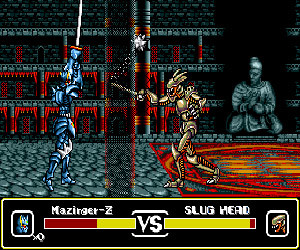 The well-handled brawling of Mazin Saga makes it all the more disappointing when the game reaches the end of a level and turns into a one-on-one fighter. For each stage's boss fight, Mazinger grows into a multi-story robot and takes on some Nagai-esque abomination in a clumsy, simplistic version of Street Fighter II. This part of the game feels like a tech demo; Mazinger's moves are limited to sword swipes, while the enemies show off more damaging weapons and actual projectiles. Each match is a tiresome fit of flailing and jumping, and it's enough to bring the game to a complete stop. Worse still, the developers clearly thought that these were the best parts of the game, perhaps because of the massively jointed characters, and they decided to repeat all of the boss fights towards the end of Mazin Saga. If that's not enough, there's even a code to reduce the entire game to these boring boss battles.
The well-handled brawling of Mazin Saga makes it all the more disappointing when the game reaches the end of a level and turns into a one-on-one fighter. For each stage's boss fight, Mazinger grows into a multi-story robot and takes on some Nagai-esque abomination in a clumsy, simplistic version of Street Fighter II. This part of the game feels like a tech demo; Mazinger's moves are limited to sword swipes, while the enemies show off more damaging weapons and actual projectiles. Each match is a tiresome fit of flailing and jumping, and it's enough to bring the game to a complete stop. Worse still, the developers clearly thought that these were the best parts of the game, perhaps because of the massively jointed characters, and they decided to repeat all of the boss fights towards the end of Mazin Saga. If that's not enough, there's even a code to reduce the entire game to these boring boss battles.
With Shin Mazinger Shōgeki! Z-Hen currently enrapturing Nagai fans, it's only fair to point them toward this odd little branch of Mazin Saga. It's enjoyable for a few minutes, until the tedious boss fights kick in and the game decides that it hates you, Mazinger, and the concept of customer satisfaction.
Sega Genesis games are, with rare exceptions, dirt cheap nowadays. Mazin Saga should cost you under ten bucks, or around fifteen if you want a box with it. Japanese copies are more expensive, as is usually the case. It's an enduring testament to the Genesis being bigger in North American than it was in Japan.
discuss this in the forum (22 posts) |
this article has been modified since it was originally posted; see change history
 Developer: Namco Bandai
Developer: Namco Bandai